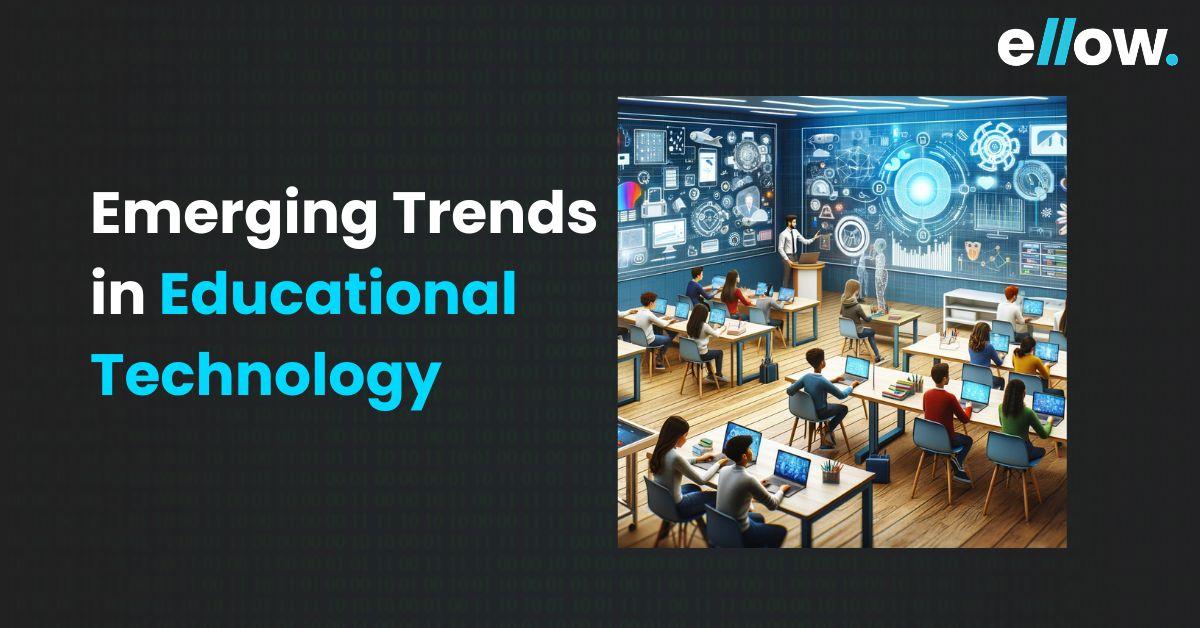Let’s build the future together.
Great ideas need great people. Partner with us to bring your vision to life, or take the first step in your career by joining our team of innovators.

The seamless integration of technology in education has become more than a mere trend, it is a transformative force shaping the way we learn and teach. The increased pace of technological evolution has led to a wave of innovations, altering the educational landscape.
As we enter 2024, exploring key trends in educational technology becomes not just a pursuit of curiosity, but a necessity in understanding how these advancements are reshaping the future of learning.
The aftermath of the COVID-19 pandemic has acted as a catalyst, propelling educational institutions to adopt digital solutions at a great pace. As the traditional boundaries of classrooms blur, the collaboration between education and technology becomes increasingly symbiotic.
The global e-learning market is expected to reach nearly 400 billion U.S. dollars by 2026, as per Statista, showcasing the extensive influence of educational technology worldwide. This growth reflects the expansive reach and impact of educational technology on a global scale.
EdTech, or Educational Technology, combines the strengths of education and technology, replacing traditional desktop computers with interactive online courses and tablets in modern classrooms. EdTech is bringing a new level of engagement to learning through virtual reality courses and gamified classroom activities.
What does an LMS in Edtech Spectrum do?
It is like orchestrating and overseeing all digital learning activities, keeping everything organized, and providing reports and analytics. It is the mastermind that keeps everything running smoothly.
Adaptive learning is a game-changer in education, tailoring teaching methods to suit each student’s unique needs. This innovative approach allows educators to gauge individual progress accurately, paving the way for personalized learning experiences.
Recent advancements in adaptive learning technologies are transforming classrooms. These tools analyze student performance, adjusting lessons in real to enhance understanding and improve overall learning outcomes.
For example, tutoring systems that adapt to a student’s strengths and weaknesses, or personalized learning platforms that offer targeted resources. These technologies empower educators to cater to diverse student needs, enhancing overall learning outcomes.
Incorporating data-driven strategies, educational institutions harness adaptive learning to create dynamic and engaging classrooms. Teachers can now fine-tune learning paths, ensuring every student progresses at their own pace.
Learning with VR and AR has transformed education, injecting excitement and interactivity into classrooms. Virtual Reality (VR) and Augmented Reality (AR) offer students a 3D journey into subjects, turning lessons into adventures. VR/AR bridges the gap in remote learning by transporting students to virtual classrooms and maintaining engagement.
Take the case of medical students using AR to visualize complex anatomy remotely. Additionally, educators benefit by creating dynamic lessons and making abstract concepts tangible.
Geography lessons come alive as students explore world landmarks through VR. As VR and AR become staples in education, the impact on traditional learning methods is undeniable. The immersive experience offered by these technologies not only captivates students but also reshapes the landscape of education as we know it.
Utilizing the power of Artificial Intelligence (AI) in education is more than just a trend, it is a transformative wave reshaping the landscape of teaching and learning. The AI market is projected to skyrocket to $1,345 billion by 2030, with education at its forefront. Imagine teachers having extra time to focus on sharpening their expertise, thanks to AI automating tasks like grading and crafting lesson plans. This not only streamlines their workload but also enhances the overall educational experience.
For students, AI acts as a personalized guide, refining writing skills and breaking down complex subjects into digestible bits. Furthermore, AI-driven analytics pinpoint learning gaps, tailoring individual learning plans for targeted improvement.
As we ride the AI wave, education becomes not just a syllabus but a personalized journey, ensuring each student gets the support they need to thrive academically.
Blockchain technology emerged as an innovative, promising, secure, and transparent academic record-keeping. It not only ensures the integrity of academic credentials but also opens the door to lifelong learner records, empowering individuals to maintain a comprehensive and secure educational history.
Blockchain facilitates the creation of micro-credentials, allowing students to showcase specific skills and competencies to potential employers and other educational institutions. The education landscape is witnessing a digital revolution with blockchain-based credentialing platforms, smart contracts, and digital wallets. Universities can now securely store and distribute course materials, fostering a more efficient and learner-centric environment.
Although blockchain adoption in education is in its early stages, its potential is undeniable. As we navigate towards a future of secure, efficient, and learner-centric systems, blockchain stands as a beacon of innovation in education.
STEAM-based programs mark a transformative trend. Combining science, technology, engineering, arts, and mathematics, these programs catalyze creativity and innovation among students, essential for navigating the rapid changes in our world. This trend is reshaping curriculum design by integrating diverse disciplines.
Edtech tools emerge as crucial enablers, offering interactive platforms, coding resources, and virtual reality applications facilitating cross-curricular activities. These tools not only enhance digital literacy but also prepare students for burgeoning opportunities in STEAM-related careers. Beyond subject knowledge, this approach nurtures critical thinking, inquiry, and innovation skills indispensable in an evolving technological landscape.
As technology evolves, the potential for integrating Ed-tech tools into cross-curricular activities continues to expand, promising more dynamic and engaging learning environments.
Beyond traditional education, there’s a growing emphasis on fostering a culture of ethical and mindful tech use. From classrooms to living rooms, strategies and programs promoting responsible tech use are emerging. Educators are incorporating digital citizenship lessons, instilling values of online etiquette, privacy, and critical thinking.
Online platforms and communities are playing a pivotal role, offering resources to educators and students alike. Just as online education gained traction post-pandemic, the focus is shifting towards ensuring that individuals not only consume content but also understand and contribute positively to the digital realm. As we continue to ride the wave of technological advancements, nurturing digital citizens becomes an integral part of education for the future.
Gamification in learning is revolutionizing education by injecting elements of games into the traditional learning environment. This approach goes beyond textbooks, transforming education into an interactive and engaging experience.
Research indicates that gamified learning captures students’ attention and significantly improves learning outcomes compared to conventional methods. Incorporating features like teamwork, leaderboards, and rewards, gamification motivates students to achieve academic goals in a fun and dynamic manner.
Successful implementations of gamification are evident in platforms like Kahoot, Sololearn, and Classcraft. These tools empower educators to design interactive quizzes, gamified study materials, and immersive classroom experiences. The global gamification market, valued at $6.33 billion in 2019, is projected to soar to $37 billion by 2027.
As technology continues to evolve, gamification emerges as a powerful tool to cater to diverse learning styles, creating a personalized and effective educational journey for students worldwide.
Big Data in education is transforming the landscape, allowing institutions to craft targeted strategies and policies. Detailed data analytics help understand student behaviors and allow the designing of personalized programs that meet individual needs. Learning management systems, data visualization tools, and predictive modeling software are becoming integral, shaping a data-driven education realm.
However, as we navigate this sea of information, privacy concerns and ethical considerations loom large. Striking a delicate balance between data utilization and safeguarding individual privacy is crucial. The power of big data, when harnessed responsibly, empowers educators and administrators to make informed decisions, fostering evidence-based practices that elevate the teaching and learning experience. As the digital education landscape expands, the responsible integration of big data remains a cornerstone for shaping the future of education.
The post-pandemic era has sustained momentum, steering educational institutions towards flexible and dynamic approaches. Remote learning, powered by online platforms, empowers students to engage with courses from any location. Meanwhile, hybrid learning seamlessly merges in-person and virtual components, offering a harmonious blend of structure and adaptability.
Yet, implementing these models is not without its technological intricacies. The quest for effective solutions is met with challenges, from optimizing learning management systems to navigating the nuances of online collaboration platforms. This trend epitomizes a paradigm shift, necessitating the integration of digital tools to foster a tech-savvy generation. The crux lies in promoting digital literacy and shaping a curriculum attuned to the demands of the digital era.
In an era dominated by technology, ensuring every student can access educational resources is paramount. This trend revolves around the pivotal need to make EdTech inclusive for all. Imagine a classroom where every student, regardless of their abilities, has equal access to learning tools. It’s not just a dream; it’s the future we’re forging.
We delve into the significance of universal access to educational technology, breaking down barriers for students with diverse needs. From screen readers to adaptive learning platforms, we’re witnessing a surge in tools championing inclusivity. This trend is reshaping the landscape of education, fostering an environment where no student is left behind.
Revolutionizing education, EdTech has become a game-changer for both students and teachers. Students enjoy 24/7 access to learning, breaking free from traditional constraints. Interactive platforms like Google Slides foster collaboration, enabling hands-on experiences with tools like Google Docs. This dynamic interaction enhances understanding and engagement.
For teachers, EdTech introduces automated grading, freeing up valuable time for personalized attention. Classroom management becomes seamless with digital tools, allowing educators to organize and streamline tasks efficiently. Additionally, EdTech empowers teachers to embrace self-paced learning, assessing students at the end of each lesson to gauge readiness for new material.
In this digital era, EdTech transforms education into a flexible, interactive, and efficient experience for both educators and learners, propelling the educational system into a future where traditional boundaries no longer define the learning journey.
EdTech, or educational technology, has become a transformative force, revolutionizing traditional teaching methods. The shift from pen-and-paper to digital platforms is not just a trend but a necessity, driven by the manifold benefits it brings to both educators and learners.
EdTech introduces innovative teaching methods by providing multimedia resources, from animations to interactive tools. This diversity accommodates various learning styles, making education more accessible and captivating for students. Online courses tailored to individual pacing empower learners to take control of their education.
Technology has made collaboration seamless. EdTech connects students and educators, creating a virtual space for discussions, idea sharing, and collaborative problem-solving. This interconnectedness enhances the sense of community in the learning process.
EdTech transforms the learning experience into an enjoyable journey. By making education interactive and dynamic, students find the process engaging and exciting. Motivated learners are more likely to retain information, and apply it effectively in their daily lives.
Discover the latest advancements shaping education, from artificial intelligence integration to immersive learning experiences, as we delve into the transformative trends in educational technology.
Learn how artificial intelligence is revolutionizing the educational landscape, from personalized learning experiences to predictive analytics, and understand the potential impact on student outcomes.
Explore the immersive realms of virtual and augmented reality in education, uncovering how these technologies are reshaping traditional teaching methods and providing students with enriched, interactive learning environments.
Delve into the ways educational technology is breaking down barriers, fostering inclusivity, and ensuring accessibility for diverse learners. Explore adaptive technologies and their role in creating a more equitable educational experience.
Understand the dual nature of the evolving educational technology landscape – explore the challenges educators may face in implementation while discovering the exciting opportunities these trends bring to the forefront of modern teaching methodologies.

How Top SaaS Companies Build Agile Teams with Remote Developers

How to Hire Vetted Remote Developers in a Hyper-Competitive Market

Top 5 Countries to Hire Remote Developers (and Why)
Please feel free to share your thoughts and we can discuss it over a cup of tea.
Get a quote
How Top SaaS Companies Build Agile Teams with Remote Developers

Six Things to Consider When Hiring Remote Talent

ellow.io enters remote hires market with AI-based screening process